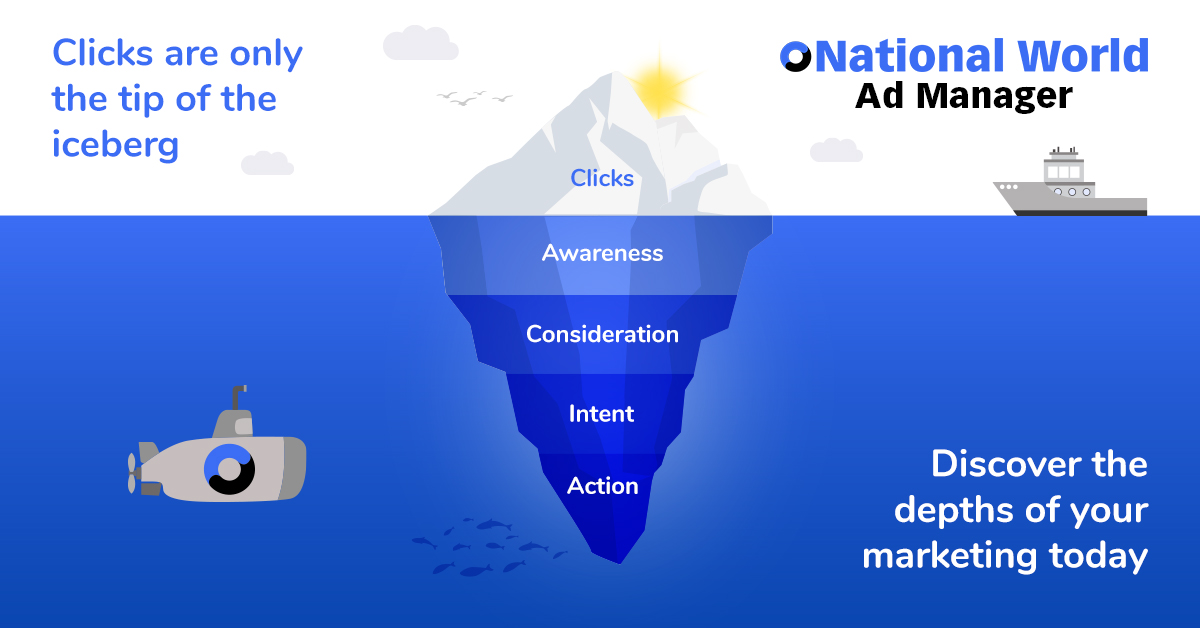
Online advertising as we know it is almost 30 years old and for most of this time people have interpreted the success of their digital ads by the same outdated measure - the number of clicks they get, and subsequent click through rate - but long gone are the days where those first ads generated a 44% CTR.
Each February, the Internet Advertising Bureau UK marks National Anti-Click-Through Rate Day, with the wry tagline ‘Don’t be a Clickhead’ calling for a better set of metrics.
At National World, we agree with the IAB wholeheartedly. Here are 5 reasons why clicks don’t really tell the whole story of your marketing, and why you shouldn’t put them at the centre of how you measure results.
In terms of understanding your audience, the problem with being a clickhead isn’t that you’re focusing on the wrong people. It’s that you’re pouring all your attention onto a tiny number of the right people.
The average click through rate for a display ad is about 0.05%. Don’t waste time, energy and money figuring out the actions of such a small proportion of your actual audience. The vast majority of people who see your ad won’t click, but that doesn’t mean your message hasn’t left an impression that you can build on.
So we now know that, proportionally, not many clicks are even happening anymore. Well, the ones that are happening are frequently either accidental or fake.
It’s been estimated that a staggering 60% of ad clicks on mobile devices happen accidentally as a result of ‘fat thumbs’. These clicks tell you nothing about your audience other than their fine motor skills (or lack thereof).
A more pressing problem is click fraud - when clicks are generated by automated bots looking to drain advertisers’ budgets, rather than human beings. While the full picture of fraudulent ad clicks is hard to gauge, approximately 90% of all PPC ad campaigns on Google and Bing are affected by click fraud . And we can be confident that it’s a growing problem.
So, many clicks on any given ad will be either accidental or fraudulent. You have to ask, what is the point of assessing this?
Even if clicks were generated deliberately, and in good faith, they aren’t necessarily what you actually want your display advertising to motivate anyway.
Your advertising campaign will be looking to achieve all or some combination of the following tasks: raising awareness of your business, showing off what you sell, becoming your target market’s business of choice, and directly generating sales.
The number of people who have clicked an ad does not tell you anything about how you’re achieving any of these goals. Clicks don’t match up to how much people are spending, nor to the impression that your products or services have left on your target market. They don’t even indicate how many people have been made aware of your business.
In fact, there seems to be no relationship at all between clicks and brand metrics or offline sales. Yet the focus on click rates continues to be a key focus for many.
One attraction of clicks is their immediacy - they give marketers a tangible number that can be watched changing in real time.
Psychologically, this delivers a little hit of validation. Seeing your ad get clicks feels good, and gives the impression that what you’re doing is working.
This is why they’re a classic vanity metric; it makes you feel good, but it doesn’t tell you anything about your business. Vanity metrics are intoxicating, which is why they’re hazardous to your chances of achieving important results.
So, if not clicks, then what?
It took a while for alternatives to click-centric measurement to really emerge and gain ground. But in the last few years, savvy businesses have used ‘brand lift’ reports, which give a fuller, more cohesive account of how your online campaigns have added value to your business, at each critical stage of the marketing process.
These comprehensive reports were once only accessible to big businesses with in-house marketing departments and considerable budgets.
We thought it was time that changed. We’ve partnered with independent analytics providers and AOP award winners Brand Metrics to make brand lift reports available to small businesses too. We are now the only local news publisher in the UK to offer brand lift studies as standard to all customers at the end of their online campaigns, including our self-serve advertising platform, National World Ad Manager.
These reports are created by the simple act of surveying users who have seen an ad and asking them directly for their impression of the company behind them: whether they remember it, feel positively towards it or intend to purchase from it.
The results are quantified and compared to a calculated baseline. This gives far more sophisticated, useful insights than a box telling you that your most recent ad got a CTR of 0.12% (if you’re lucky).
Click here for more advice on getting the true picture of your marketing with a brand lift report.
For too long, click rates have served as the go-to for marketers in search of a quick metric to justify their work. Now it’s time to kick the habit.
You need to know the effect of your marketing on your brand awareness, your reputation and people’s real likelihood of buying from you. That’s something clicks won’t give you, but a brand lift report will.
Enjoyed this article? We’ve got more stashed away here: